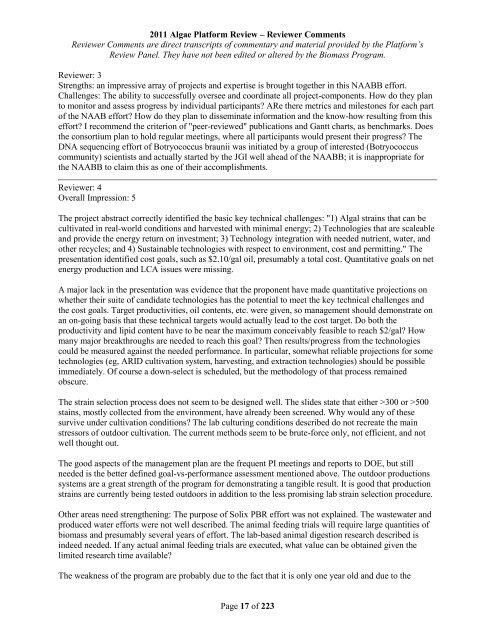Reviewer Comments - EERE
Reviewer Comments - EERE
Reviewer Comments - EERE
You also want an ePaper? Increase the reach of your titles
YUMPU automatically turns print PDFs into web optimized ePapers that Google loves.
2011 Algae Platform Review – <strong>Reviewer</strong> <strong>Comments</strong><br />
<strong>Reviewer</strong> <strong>Comments</strong> are direct transcripts of commentary and material provided by the Platform’s<br />
Review Panel. They have not been edited or altered by the Biomass Program.<br />
<strong>Reviewer</strong>: 3<br />
Strengths: an impressive array of projects and expertise is brought together in this NAABB effort.<br />
Challenges: The ability to successfully oversee and coordinate all project-components. How do they plan<br />
to monitor and assess progress by individual participants? ARe there metrics and milestones for each part<br />
of the NAAB effort? How do they plan to disseminate information and the know-how resulting from this<br />
effort? I recommend the criterion of "peer-reviewed" publications and Gantt charts, as benchmarks. Does<br />
the consortium plan to hold regular meetings, where all participants would present their progress? The<br />
DNA sequencing effort of Botryococcus braunii was initiated by a group of interested (Botryococcus<br />
community) scientists and actually started by the JGI well ahead of the NAABB; it is inappropriate for<br />
the NAABB to claim this as one of their accomplishments.<br />
<strong>Reviewer</strong>: 4<br />
Overall Impression: 5<br />
The project abstract correctly identified the basic key technical challenges: "1) Algal strains that can be<br />
cultivated in real-world conditions and harvested with minimal energy; 2) Technologies that are scaleable<br />
and provide the energy return on investment; 3) Technology integration with needed nutrient, water, and<br />
other recycles; and 4) Sustainable technologies with respect to environment, cost and permitting." The<br />
presentation identified cost goals, such as $2.10/gal oil, presumably a total cost. Quantitative goals on net<br />
energy production and LCA issues were missing.<br />
A major lack in the presentation was evidence that the proponent have made quantitative projections on<br />
whether their suite of candidate technologies has the potential to meet the key technical challenges and<br />
the cost goals. Target productivities, oil contents, etc. were given, so management should demonstrate on<br />
an on-going basis that these technical targets would actually lead to the cost target. Do both the<br />
productivity and lipid content have to be near the maximum conceivably feasible to reach $2/gal? How<br />
many major breakthroughs are needed to reach this goal? Then results/progress from the technologies<br />
could be measured against the needed performance. In particular, somewhat reliable projections for some<br />
technologies (eg, ARID cultivation system, harvesting, and extraction technologies) should be possible<br />
immediately. Of course a down-select is scheduled, but the methodology of that process remained<br />
obscure.<br />
The strain selection process does not seem to be designed well. The slides state that either >300 or >500<br />
stains, mostly collected from the environment, have already been screened. Why would any of these<br />
survive under cultivation conditions? The lab culturing conditions described do not recreate the main<br />
stressors of outdoor cultivation. The current methods seem to be brute-force only, not efficient, and not<br />
well thought out.<br />
The good aspects of the management plan are the frequent PI meetings and reports to DOE, but still<br />
needed is the better defined goal-vs-performance assessment mentioned above. The outdoor productions<br />
systems are a great strength of the program for demonstrating a tangible result. It is good that production<br />
strains are currently being tested outdoors in addition to the less promising lab strain selection procedure.<br />
Other areas need strengthening: The purpose of Solix PBR effort was not explained. The wastewater and<br />
produced water efforts were not well described. The animal feeding trials will require large quantities of<br />
biomass and presumably several years of effort. The lab-based animal digestion research described is<br />
indeed needed. If any actual animal feeding trials are executed, what value can be obtained given the<br />
limited research time available?<br />
The weakness of the program are probably due to the fact that it is only one year old and due to the<br />
Page 17 of 223




